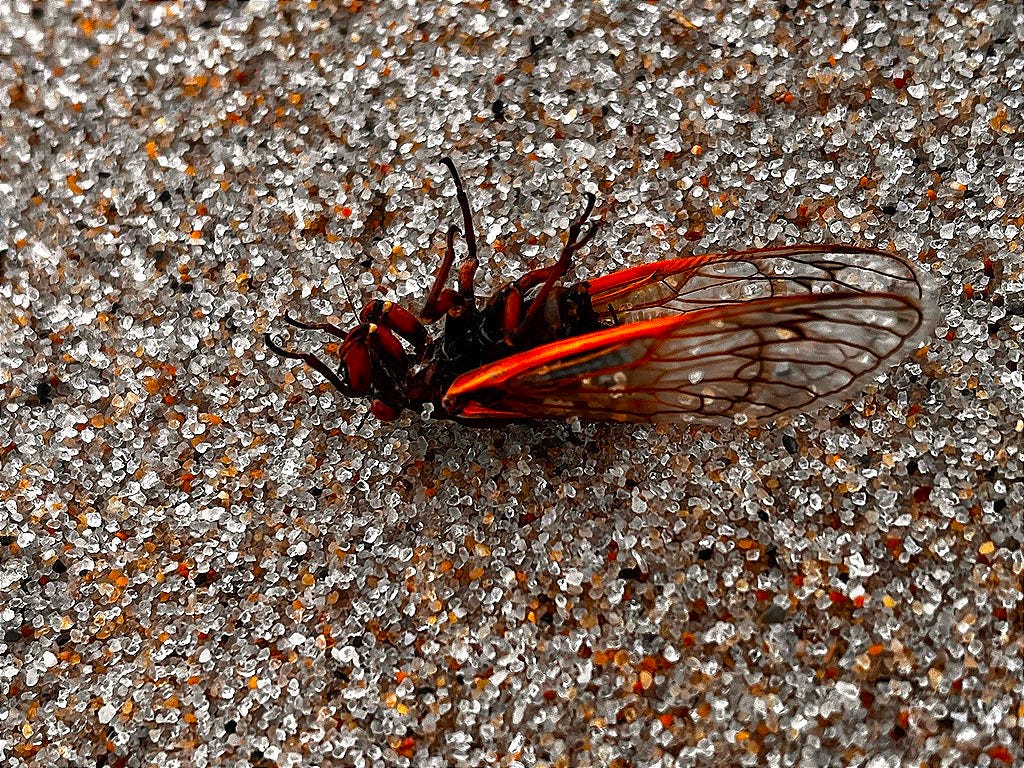Circles, Cycles, Cicadas
"The whole cycle of changes returns into itself, just as do the metamorphoses of an insect." C. Lyell & L. Lyell, Principles of Geology (ed. 12) vol. II, 1875
Because the tide was at dead low when I got up yesterday, I set out for a morning walk not yet quite awake. Still in that half-dreaming pre-coffee state of mind, I wandered along the wrack-line to the enchanted music of water, light, and drifting clouds. Every tide brings in interesting things, often unusual things. Strewn along the low-tide line on this day were hundreds of large dead insects. Bending down to look, I saw they were cicadas. Their startling orange eyes and transparent wings laced with orange veins identified them as members of the periodic cicada population that appears only once every 17 years — quite different from the cicadas we see every year. Their rare appearance is a startling demonstration of the rhythm of the universe.
These are fascinating creatures. As George Hamilton, Extension Specialist in Pest Management explains in a factsheet put out by the New Jersey Agricultural Experiment Station at Rutgers University (which also includes good detail on their life cycle):
For convenience of reference, emerging broods have been designated by Roman numerals. Numerals I through XVII are assigned to the 17-year broods and species. They are assigned as though a brood were to emerge each consecutive year. The system began with the 1893 brood (Brood I). The 1894 brood was Brood II, and so on. Thirteen-year species, found in the Southern states, are numbered XVIII through XXX. The habitats for all species overlap and there may be some gaps in both 17 and 13-year broods.
After spending 17 years underground feeding on tree roots, this insect emerges for just a few weeks — solely to mate and reproduce. They don’t eat at all during their short time above ground. The male of the species has special paired structures on its undersides called tymbals with which to make the “Pharaoh” call to attract females. To some ears, the call sounds like the word ‘pha…roah’ though I’m hard-pressed to hear it that way. Repeated contraction and relaxation of the tymbal makes the distinctive sound, which can reach 80-100 decibels. Put hundreds and thousands of these dudes together and … you just might want to plug your ears!
Native Americans believed a cicada invasion portended evil. And when swarms of periodic cicadas appeared suddenly by the millions, early American colonists, never having seen them before, thought a plague of locusts had been visited upon them and named them "17-Year Locusts."
Anyway, back to my beach discovery: just a day earlier I had been listening to Mark Faherty's piece on WCAI titled "More birds are enjoying the cicada buffet" so I knew I was seeing something unusual. Spotting an extra-large specimen, and with my usual plastic bag stuffed in one pocket, I thought I'd bring it back for a closer look later. But it turned out the clean-up crew was already at work: a band of sand fleas was busily enjoying a feast. So I took a video instead:
Cicadas aren't a threat in any way -- on the contrary, they can actually benefit the ecosystem by providing food for birds, fish, and other wildlife, feeding the soil as they die and decompose, and even helping forests grow by naturally pruning trees. For some people their most annoying feature may be their deafeningly loud mating call.
There is one downside to having these temporary hordes in our midst: the mites that feed on cicada eggs can bite humans. I’m pretty sure this explains a very itchy, bumpy rash that appeared on my ankle the day of this beach walk: According to WebMD,
"…cicada eggs are a food source for oak leaf itch mites — tiny arachnids that aren't even a quarter of a millimeter in length and that are "invisible to the naked eye." Each fall, several states have reported outbreaks of the pests, otherwise known as Pyemotes herfsi. They've been linked to cicadas before, with the Illinois Department of Public Health releasing a report in 2008 that said cicadas were the only insect parasitized by the mites the year prior. It was the first confirmed report of the mites terrorizing cicada eggs at the time.
"Brood XIII periodical cicadas emerged earlier in the year and laid large numbers of eggs in the terminal branches of many deciduous tree species in the outbreak area," the report says. "It appears that this abundance of cicada eggs served as the host upon which populations of P. herfsi mites amplified to outbreak levels."
In closing: I had planned this week to write about delusions of grandeur — but discovering the cicadas led me down a different path. I see a connection though: Americans are in the first quarter of a tumultuous cycle that has much of the world fearful and on edge. Perhaps the coincident appearance of the 17-year cicadas at this particular time is a message reminding us that a cycle is a continuous change, or a sequence of changes, in the state of a system. By definition, it results in the system being restored to its original state after a certain defined period of time.






I love this post and its hopeful ending. Thank you
I love this too! The cycle is a comforting and hopeful concept.